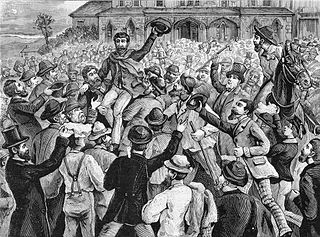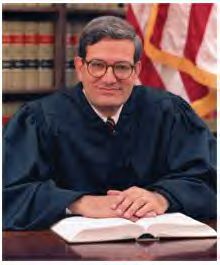A sheriff is a government official, with varying duties, existing in some countries with historical ties to England where the office originated. There is an analogous, although independently developed, office in Iceland that is commonly translated to English as sherif.
In law, a judgment, also spelled judgement, is a decision of a court regarding the rights and liabilities of parties in a legal action or proceeding. Judgments also generally provide the court's explanation of why it has chosen to make a particular court order.

In common law jurisdictions, an acquittal means that the prosecution has failed to prove that the accused is guilty beyond a reasonable doubt of the charge presented. It certifies that the accused is free from the charge of an offense, as far as criminal law is concerned. The finality of an acquittal is dependent on the jurisdiction. In some countries, such as the United States, an acquittal prohibits the retrial of the accused for the same offense, even if new evidence surfaces that further implicates the accused. The effect of an acquittal on criminal proceedings is the same whether it results from a jury verdict or results from the operation of some other rule that discharges the accused. In other countries, like Australia and the UK, the prosecuting authority may appeal an acquittal similar to how a defendant may appeal a conviction — but usually only if new and compelling evidence comes to light or the accused has interfered with or intimidated a juror or witness.

Foreclosure is a legal process in which a lender attempts to recover the balance of a loan from a borrower who has stopped making payments to the lender by forcing the sale of the asset used as the collateral for the loan.
United States v. Dominguez Benitez, 542 U.S. 74 (2004), was a United States Supreme Court case in which the Court ruled that, in a criminal proceeding in federal court, a defendant who does not alert the district court to a possible violation of Rule 11 of the Federal Rules of Criminal Procedure must show on appeal that the violation affirmatively affected his rights in order to obtain reversal of his conviction by guilty plea. Rule 11, which pertains to criminal prosecutions in United States federal courts only, governs the offering of plea bargains to criminal defendants and the procedures district courts must employ to ensure that the defendant knows of and properly waives his trial-related constitutional rights.
A writ of coram nobis is a legal order allowing a court to correct its original judgment upon discovery of a fundamental error that did not appear in the records of the original judgment's proceedings and that would have prevented the judgment from being pronounced. The term coram nobis is Latin for "before us" and the meaning of its full form, quae coram nobis resident, is "which [things] remain in our presence". The writ of coram nobis originated in the courts of common law in the English legal system during the sixteenth century.

José Alberto Cabranes is an American lawyer who serves as a senior United States circuit judge of the United States Court of Appeals for the Second Circuit and a former presiding judge of the United States Foreign Intelligence Surveillance Court of Review ("FISCR"). Formerly a practicing lawyer, government official, and law teacher, he was the first Puerto Rican appointed to a federal judgeship in the continental United States (1979).

Pennzoil is an American motor oil brand currently owned by Shell plc. The former Pennzoil Company had been established in 1913 in Pennsylvania, being active in business as an independent firm until it was acquired by Shell in 2002, becoming a brand of the conglomerate.
Audita querela is a writ, stemming from English common law, that serves to permit a defendant who has had a judgment rendered against him or her to seek relief of the consequences of such a judgment where there is some new evidence or legal defense that was not previously available. The writ is thus generally used to prevent a judgment from being executed where enforcement of that judgment would be "contrary to justice". At common law, the writ may be useful where a creditor engages in fraud before the judgment is rendered, or because the debt had been discharged, paid or otherwise satisfied after the judgment is rendered.
Robert David Sack is a senior United States circuit judge of the United States Court of Appeals for the Second Circuit.
Dennis Jacobs is a senior United States circuit judge of the United States Court of Appeals for the Second Circuit.

Thomas Lee Ambro is a Senior United States circuit judge of the United States Court of Appeals for the Third Circuit.
Pro se legal representation comes from Latin pro se, meaning "for oneself" or "on behalf of themselves" which, in modern law, means to argue on one's own behalf in a legal proceeding, as a defendant or plaintiff in civil cases, or a defendant in criminal cases, rather than have representation from counsel or an attorney.
The collection of judgments in Virginia may be accomplished under a number of routes provided under Virginia law, depending on the amount of the judgment and the particular assets that the judgment creditor wishes to pursue.
Logan v. United States, 552 U.S. 23 (2007), was a case before the United States Supreme Court.
Rule B attachments are issued under Rule B of the Supplemental Rules for Certain Admiralty and Maritime Claims of the Federal Rules of Civil Procedure. Under that provision, the court is allowed to attach a defendant's property up to the value of the suit. Although these claims are filed during in personam actions, they are in rem in nature, as the Court is attaching property to the suit. This has been described as a "remedy quasi in rem."
Civil procedure in South Africa is the formal rules and standards that courts follow in that country when adjudicating civil suits. The legal realm is divided broadly into substantive and procedural law. Substantive law is that law which defines the contents of rights and obligations between legal subjects; procedural law regulates how those rights and obligations are enforced. These rules govern how a lawsuit or case may be commenced, and what kind of service of process is required, along with the types of pleadings or statements of case, motions or applications, and orders allowed in civil cases, the timing and manner of depositions and discovery or disclosure, the conduct of trials, the process for judgment, various available remedies, and how the courts and clerks are to function.
Bank of America, N. A. v. Caulkett, 575 U.S. 790, 135 S. Ct. 1995 (2015), is a bankruptcy law case decided by the Supreme Court of the United States on June 1, 2015. In Caulkett, the Court held that 11 U.S.C. § 506(d) does not permit a Chapter 7 debtor to void a junior mortgage on the debtor's property when the amount of the debt secured by the senior mortgage on that property exceeds the property's current market value.
Mont v. United States, No. 17-8995, 587 U.S. ___ (2019), is a United States Supreme Court case concerning the proper interpretation of "supervised release" under 18 U.S.C. §3624(e). The case involved a prisoner who was convicted on drug distribution charges and was sentenced to imprisonment and supervised release. While on supervised release, he was charged and pleaded guilty to various state-law offenses, but due to administrative delays, his sentence was not entered until after the day on which his supervised release was to end. He was nonetheless charged with violating the terms of his supervised release, and he sought to challenge the court's jurisdiction to hear the case, arguing that his pretrial detention for the later offenses. The question in the case was whether a term of supervised release for one event can be tolled (paused) by imprisonment for another offense.
Howes v. Fields, 565 U.S. 499 (2012), was a decision by the U.S. Supreme Court that an interrogation of a prisoner was not a custodial interrogation per se, and certainly it was not "clearly established federal law" that it was custodial, as would be required by the Antiterrorism and Effective Death Penalty Act (AEDPA). Instead, the Court said, whether the interrogation was custodial depended on the specific circumstances, and moreover, in the particular circumstances of this case, it was not custodial. This decision overturned the rule of the Sixth Circuit, and denied the prisoner's habeas corpus petition.




